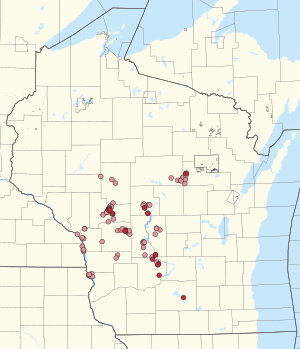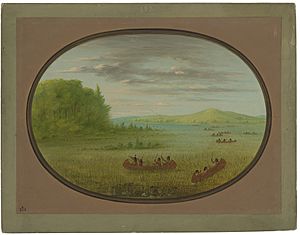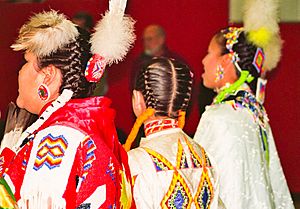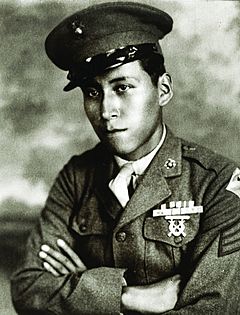Ho-Chunk Nation of Wisconsin facts for kids
| Hocąk | |
|---|---|
 |
|
| Total population | |
| 6,563 in 2010 | |
| Regions with significant populations | |
| Languages | |
| English, Ho-Chunk | |
| Religion | |
| Waaksik Wosga, Native American Church | |
| Related ethnic groups | |
| other Ho-Chunk, Otoe, Iowa people, and Missouria |
The Ho-Chunk Nation (in their own language, Ho-Chunk: Hocąk) is a recognized tribe of the Ho-Chunk people. Their traditional lands spread across five states in the United States: Wisconsin, Illinois, Iowa, Minnesota, and Missouri. Another recognized group of Ho-Chunk people is the Winnebago Tribe of Nebraska. These two tribes separated long ago when some members were forced to move from their homes. They were moved to Iowa, then Minnesota, South Dakota, and finally to a reservation in Nebraska.
Historically, other tribes called them "Winnebago," a name that the French and English also started using. However, the Ho-Chunk people have always called themselves Ho-Chunk. The name Ho-Chunk comes from their word Hocaagra. This means "People of the Sacred Voice."
Contents
How the Ho-Chunk Nation is Governed
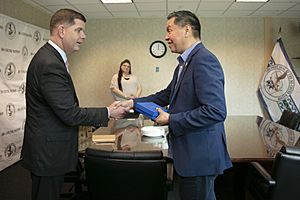
The main office for the Ho-Chunk Nation is in Black River Falls, Wisconsin. In 1994, the tribe created a new constitution. This constitution brought back their original name, the Ho-Chunk Nation. It also set up their government to be like the US federal and state governments.
The Ho-Chunk Nation government has three main parts:
- The executive branch is led by the President.
- The legislative branch makes laws.
- The judicial branch includes the Supreme Court.
The tribe's members also form a fourth important part of the government, called the general council. The current president of the Ho-Chunk Nation is Marlon WhiteEagle. The Chief Justice of their Supreme Court is Todd R. Matha.
Ho-Chunk Nation Lands
The Ho-Chunk Nation is sometimes called a "non-reservation" tribe. This is because their lands are not all connected in one big area. Instead, their lands are spread out in many different places. Many tribal members own their own land privately. The tribe also manages special areas of land called "Trust Land." These lands are held by the federal government for the tribe.
These trust lands are located in many counties across Wisconsin. Some of these land areas have been given official reservation status by the government. The Ho-Chunk Nation is always working to get more of their traditional lands back. They want to place these lands into trust status for the tribe.
In 2020, the Ho-Chunk Nation's reservation lands and other trust lands covered about 16 square miles (41.5 square kilometers). About 1,577 people lived on these lands in 2020.
Ho-Chunk Culture and Traditions
The Ho-Chunk people traditionally grew many crops for food. These included corn, squash, and beans. They would store their food in bags and in pits dug in the ground to use during winter. They also traveled to hunt small and large animals. They would cross the Mississippi River to hunt buffalo on the prairies. Fishing in nearby rivers and lakes was also a way they found food.
The Ho-Chunk held many important ceremonies. The Medicine Dance was a major summer ceremony. It included both secret parts for members of a religious society and public rituals. The winter feast was a clan ceremony. It was meant to help with hunting and war powers. The spring Buffalo Dance was a magical ceremony to call the bison herds.
Ho-Chunk women were very important in providing food for their families. They grew crops and gathered many kinds of roots, nuts, and berries. They also collected sap from maple trees. Women knew how to use many plants for medicine. They cooked game and prepared meals for hunters. They also tanned animal hides to make clothing and bags.
Ho-Chunk men were skilled hunters and warriors. They would catch fish using spears and clubs. They also hunted animals like muskrat, mink, otter, beaver, and deer. Leaders among the men handled relationships with other tribes. Some men made jewelry from silver and copper. Boys would go through a special rite of passage at puberty. They would fast for a time, hoping to gain a guardian spirit.
Ho-Chunk Language: Hocąk
The Ho-Chunk Nation speaks the Ho-Chunk language (Hocąk). This language is part of the Siouan-Catawban language family. Today, fewer and fewer elders speak Hocąk. Because of this, the tribe has created a Language Division. This group works to record and teach the language.
They have programs to help bring the language back to life. One program is called "EeCoonį." This program is held at Christmas Mountain in Wisconsin Dells. It helps young children learn the language by spending time with language teachers and fluent speakers.
Ho-Chunk History and Modern Life
The Ho-Chunk people have a rich oral history that goes back thousands of years. Their stories tell of their people living through three different ages. Oral history suggests that the US government forced some of the tribe to move up to 13 times. This was often done to take their land. In the 1870s, most of the tribe returned to their homelands in Wisconsin. Some tribal members were able to gain ownership of small pieces of land.
The Ho-Chunk Nation's flag was adopted in 1992. Its five colors (red, white, green, blue, and black) each represent different animal clans. They also have special meanings in the tribe's oral history. The flag shows the nation's seal.
Today, the Ho-Chunk Nation owns and runs several casinos called Ho-Chunk Gaming. These are located in places like Black River Falls, Baraboo, and Madison. They also own restaurants, hotels, and gas stations. The Ho-Chunk Nation is a very large employer in Jackson and Sauk counties. They employ about 3,100 people.
In 2015, the Ho-Chunk Nation made a resolution to add the rights of nature to their constitution. This means they are working to make sure that nature itself has rights, just like people do.
Notable Ho-Chunk People
Here are some well-known people from the Ho-Chunk Nation:
- Glory of the Morning (died around 1832), an important tribal leader.
- Truman Lowe (born 1944), an artist, museum curator, and professor.
- Mitchell Red Cloud Jr. (1924–1950), a US Marine and a hero of the Korean War.
- Bronson Koenig (born 1994), a basketball player who played for the University of Wisconsin Badgers.
- Harry Whitehorse (1927–2017), a US sailor who fought in World War II and was also an artist.
- Sharice Davids (born 1980), a member of the US House of Representatives from Kansas.
- Sky Hopinka (born 1984), an artist and filmmaker.
- Dr. Helen Miner Miller (born 1925), an educator and the first tribal chair.
- John Raymond Rice (1914–1950), a US Army sergeant who was killed in the Korean War.


